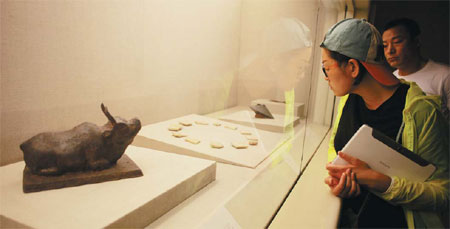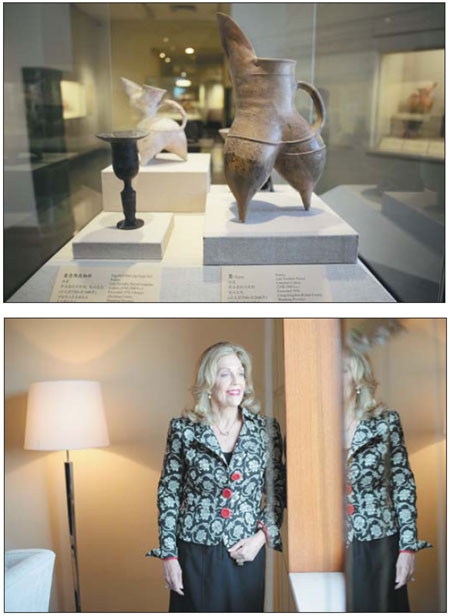Ancient artifacts, modern museum
Updated: 2013-06-09 08:12
By Peng Yining(China Daily)
|
|||||||||
|
Visitors inspect the rich collection at the Arthur M. Sackler Museum of Art and Archaeology in Peking University. Photos by Wang Jing / China Daily |
|
From top: The museum's collection spans a period of 280,000 years. Jill Sackler has been supporting the museum since her husband passed away in 1987. |
An archaeology museum endowed to Peking University by a US philanthropist in 1993 is still a world-class facility. Peng Yining reports from Beijing.
When Song Xiangguang studied archaeology at Peking University in the 1980s, the department was scant on resources, despite the university being the leading archaeology school in China since the 1930s. Song vividly remembers handling ancient ceramics in a dusty classroom that was used as a specimen room, verifying what age they were from in the dim light.
"When I first heard Mr Sackler, an art collector from the United States, was going to endow a museum at our school, I thought, 'Good. They are going to improve the specimen room', but in fact, they built a world-class teaching museum," said Song, now the deputy director of the Arthur M. Sackler Museum of Art and Archaeology at PKU. "More importantly, they brought the advanced idea of archaeology and museology to China. This museum also symbolizes the friendship between the two countries."
In a leafy corner near the West Gate of the PKU campus, the concrete-framed two-story museum with a traditional clay tile gambrel roof harmonizes with the other buildings in the university. Surrounded by a small pond and a classical Chinese garden, the museum is also conspicuous for its polychromed bracketing on the eaves that gleam under the summer sun.
By the museum's front gate is a bronze bust of the late Arthur M. Sackler, a scientist, art collector and the museum's benefactor.
As one of the world's great art collectors and connoisseurs, Sackler collected objects and paintings from various parts of the world and from different periods - from ancient times to the present. He was also a major benefactor to museums, universities and other institutions in the arts, sciences, and humanities. In addition to the Arthur M. Sackler Gallery at the Smithsonian in Washington DC in the US, Sackler endowed several museums worldwide, including a teaching museum at Harvard University.
Sackler's major focus, however, was Chinese art. He once wrote that after discovering some Chinese ceramics and Chinese Ming furniture in 1950, his life was never the same.
"He spotted a small Ming Chinese table in the corner of a store, and he asked where more could be obtained. He was attracted by its subtle and strong lines. He really enjoyed its restrained power and elegance," said Jill Sackler, Sackler's widow, who has been supporting the museum at PKU since her husband passed away in 1987.
Jill Sackler said she still has the table from Ming Dynasty (1368-1644), at her home in New York City.
She said her husband was very interested in preserving China's rich history for future generations, and his offer to build a teaching museum was accepted by the Chinese government in the 1980s. PKU was chosen by Chinese officials as the location, as its archaeology department was the best in China.
"He knew that people in China would benefit from a teaching museum," said Jill Sackler.
She said in the 1980s there was very little experience of cooperation between China and the West, so the museum could be considered a bridge connecting different countries and cultures.
Opened in 1993, the museum's collection consisted of more than 10,000 objects at that time, spanning a period of 280,000 years, from Paleolithic hominids and stone-tool remains to costumes, ceramics and paintings from the current era.
It was China's first teaching museum, and was also the only museum in China to be equipped with modern technology such as temperature- and humidity-controlled environments, air conditioning, lights from Czechoslovakia and display cases from Germany, said Song, the museum's deputy director.
On May 27, to celebrate its 20th anniversary, the museum presented an exhibition of cultural relics unearthed at a 1,000-year-old graveyard belonging to a noble's family in the Northern Song Dynasty (960-1127).
Zhang Yun, archeologist and excavator, said the site was regarded as one of the "Ten Greatest Archeology Discoveries in China in 2010".
"Although it is a teaching museum, Sackler museum at Peking University represents a high academic level of archaeology in China," said Zhang. "That's why we chose the museum to display the relics for the first time."
She said the design of the exhibition is outstanding: All relics have been professionally sorted with different categories and objects artistically arranged in the exhibition hall. Visitors can not only see artifacts from a noble family's grave, but also learn about the lifestyle and the ideology of people from the Northern Song Dynasty.
"After 20 years of development we still have a lot to do, and it is a good chance to learn how to work in a museum, because it is a complex project requiring cooperation and joint efforts from teams of professionals from the US and China," Song said.
Sponsored by the Arthur M. Sackler Foundation for Arts, Sciences and Humanities, Song went to the US to learn archaeology and museology in 1987. He said he was impressed by how much museums contribute to public education in the US. "It is all about knowledge, and sharing. People, especially children, can learn so much through an exhibition. They can watch, listen and even touch the objects to learn," he said.
Song said he was also impressed by how much the museums were involved in current affairs. "There were exhibitions about civil rights and women's rights. Instead of being just display places, museums in the US are alive and full of interaction," he said. "I wouldn't have learned all this if I didn't work for the AMS museum in PKU, and now we are trying to practice what we have learned in the US."
Song said his museum has 50,000 to 60,000 visitors a year, mostly students at PKU.
Xiao Jieming, 22, a student majoring in museology at PKU, said the museum is a great place to learn. Being an intern and one of the 30 volunteer tour guides at the museum, Xiao has worked on several exhibitions. She said the museum, with a high academic standard and good reputation, has been attracting students from different majors to visit or do volunteer work.
"It's not the biggest museum in China, but it imparts the most knowledge about archaeology, and it gives me a chance to practice what I have learned in the textbook," she said. "I am proud I have been a part of the museum that is capable of training the next generation of Chinese leaders in the field of archaeology and museology."
Contact the writer at pengyining@chinadaily.com.cn.
(China Daily 06/09/2013 page6)

